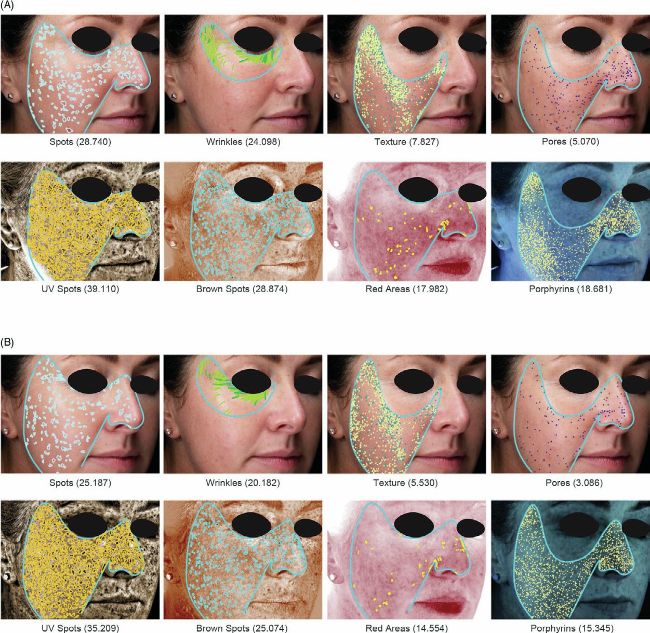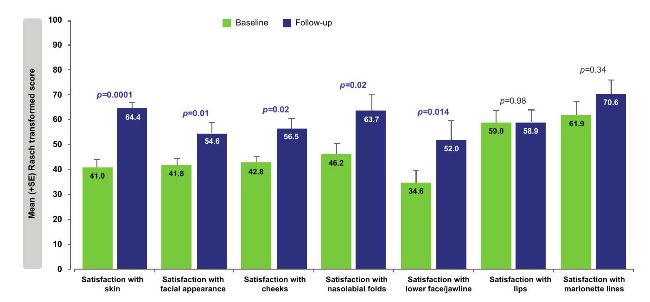REGENERATING SKIN WITH GR OWTH FACTORS
As interest and demand in regenerative aesthetics continue to grow, practitioners need to be aware of the options available to them and how each works to enhance skin quality.
One treatment method that is becoming increasingly popular is the use of growth factors. But what are they? And how effective can they be?
Here we will explore growth factors in more detail and review a recent clinical study.
UNDERSTANDING GROWTH FACTORS
Responsible for maintaining homeostasis to keep the skin alive and healthy, growth factors are essential proteins that are naturally produced by skin cells. They were first discovered by two scientists in the 1950s, who went on to receive a Nobel Prize for their work in 1986.
Growth factors are produced and secreted by skin cells such as fibroblasts, keratinocytes, and melanocytes. One type of these growth factors is known as cytokines, which are involved in regulating the immune system and repairing the skin.1
According to research, successful skin repair requires a balance between the function of multiple growth factors and cytokines. Multiple clinical studies have now demonstrated a significant increase in the production of new collagen when physiologically balanced growth factor mixtures are applied.1
Growth factors can be bioengineered in a lab or taken from an animal or human stem cells; all of which have clinical studies supporting their effectiveness.
CLINICAL STUDY
Three UK-based aesthetic practitioners endeavoured to explore the impact that topical growth factors had when combined with home-based micro-needling.2
Dr Daniel Quinlan, Mr Ali Ghanem and Dr Haidar Hassan examined 11 healthy female patients, aged 33-61, with mild to moderate facial wrinkling over a threemonth period.
They explain, “As people age, their stem cell count and production of growth factors decrease. Administering growth factors aims to replenish the skin’s depleted levels and regulate the activity of fibroblasts and collagen production.”
METHOD
Eligible study participants were healthy women over the age of 20, who had not undergone any surgical or non-surgical aesthetic, laser, or cosmeceutical treatment in the last six months. It was also ensured that they did not have any active dermatological diseases, did not smoke, and did not have any contraindications to treatment.
Upon their first clinic visit, the participants underwent a full medical and social history as well as a clinical examination. They were also given a thorough overview of what to expect from the study.
The practitioners highlight, “Skin examination was carried out to detect the skin phototypes according to the Fitzpatrick classification. Photoageing type according to the Glogau Classification was also recorded.”
Skin analysis was conducted with a VISIA Imaging System device, and each participant completed a FACE-Q patient-reported outcome measure questionnaire.
The practitioners kept in touch with the participants via text and phone calls throughout the study period, before all measures were taken again at the end of the 12 weeks.
GROWTH FACTOR APPLICATION
Participants were given two products to apply – the SkinGenuity Regenerative Serum and the SkinGenuity Reparative Serum. Manufactured by SkinGen International, the products use Nobel Prize-winning advanced Inter-Cell Messenger Technology and contain the following growth factors:
• sh-Polypeptide-1 (basic fibroblast growth factor [bFGF])
• sh-Polypeptide-11 (acidic fibro- blast growth factor [aFGF])
• sh-Polypeptide-31 (insulin-like growth factor-2 [IGF-2])
• sh-Oligopeptide-2 (insulin-like growth factor-1 [IGF-1])
• sh-Polypeptide-10 (keratinocyte growth factor-2 [KGF- 2])
• sh-Polypeptide-5 (transforming growth factor-β3 [TGF-β3])
• sh-Polypeptide-8 (platelet-derived growth factor A [PDGF-A])
• sh-Polypeptide-3 (keratinocyte growth factor-1 [KGF-1])
• sh-Polypeptide-62 (hepatocyte growth factor [HGF])
• acetyl octa- peptide-17 amide (a mini epidermal growth factor [EGF])
The researchers explain, “Each of the ten growth factors is nano-encapsulated to reduce their size, therefore enabling specific depth penetration into the dermis. The Reparative Serum also contains additional active skin conditioning ingredients, including plant extracts, peptides, protective antioxidants to minimise free radical damage, moisturisers, and humectants to improve skin hydration, DNA repair enzymes, roxisomes, ultrasomes and retinol.”
They continue, “The Reparative Serum optimises the effect of the Regenerative Serum by aiding skin absorption of the growth factors, by delivering additional growth factors at a lower dose, and peptides, as well as sealing in the growth factors so that they have more chance of being effective.”
Participants were instructed to administer two to three pumps of the Regenerative Serum onto clean skin morning and evening. Once absorbed, they were then asked to apply two to three pumps of the Reparative Serum. They were also encouraged to apply sunscreen after both products each morning.
MICRO-NEEDLING ADMINISTRATION
Participants were asked to perform a micro-needling treatment on their face twice a week using the EMPRESS MF 0.2mm applicator from SkinGen. This also contained a concentrated solution of the growth factors listed above.
Topical anaesthetic cream was applied for 10 minutes before each procedure and participants were advised to avoid microneedling inside the orbital bone and on the lips.
RESULTS
The VISIA image analysis found that there was a statistically significant mean improvement in total scores for:
• Skin texture: 17.6%
• Wrinkles: 17.3%
• Red areas: 12.4%
• Brown spots: 6% Numerical improvement in the mean scores for the following was also seen:
• Pores: 11.5%
• Skin surface spots: 0.9%

VISIA Skin Analysis of a 38-year-old female participant (Fitzpatrick Skin Type I) at baseline (A) and three-month follow-up (B). Total scores for each parameter are shown. A lower score implies an improved outcome.

Mean Rasch transformed scores at baseline and three-month follow-up with corresponding P-values. A greater score implies more prominent satisfaction.
The table above outlines results from the FACE-Q questionnaires, which demonstrate improved satisfaction with skin (p = 0.01), facial appearance (p = 0.1), cheeks (p = 0.2), nasolabial folds (p = 0.2) and lower face and jawline (p = 0.014), lips (p = 0.98) and marionette lines (p = 0.34).
The researchers note, “When expressing these results as averaged improvement, improvements in the different FACE-Q scales ranged between 31% and 57%... In addition, several participants recorded that they observed a noticeable improvement in their skin texture beginning within a few weeks of treatment initiation.”
DISCUSSION
While the results of this study are promising, the researchers did note some limitations. As well as the small number of participants, they highlight the shallow depth of the micro-needling device (0.2mm), which is the maximum depth allowed for at-home penetration.
The researchers also suggest it would be beneficial to include an additional control group receiving only topical growth factors or micro-needling alone, to better assess the value of combining the two.
They add, “Additional quantitative outcomes such as wrinkle topography and hydration or elasticity measurements would also have been useful,” while noting that the VISIA device did not evaluate skin parameters on the forehead, where the growth factor preparation was also applied, so results from this would have been beneficial too.
Despite the limitations, the researchers conclude that the data suggests combining topically applied growth factors with transdermal delivery via a micro-needling device improves skin texture and reduces the appearance of wrinkles.
They say, “Participants receiving three months of home treatment with a combination of topical and microneedling applied growth factors showed improvement in several objective facial skin aesthetic parameters, including wrinkles, skin texture and red areas, as well as improved participant satisfaction. The combination of the two treatments applied appears to be an effective antiageing regimen.”
OFFERING GROWTH FACTOR TREATMENTS TO YOUR PATIENTS
As outlined in this article, growth factors present an effective solution to numerous facial aesthetic concerns. Their use appeals to patients who are increasingly becoming aware and interested in regenerative aesthetic tools that have scientific backing.
Delivery methods can vary and, as demonstrated in the clinical study outlined here, combination approaches can be particularly effective. As suggested by the researchers, deeper micro-needling allowed in a clinical setting could offer enhanced results, while ensuring your patients thoroughly understand and adhere to any home protocols you suggest is essential.
When you offer patients growth factor products that have positive clinical research behind them, you will likely see promising results.
Note: the study mentioned in this article did not receive funding and none of the researchers has a financial interest in any of the products or devices mentioned.
REFERENCES
1. Pamela RD.Topical Growth Factors for the Treatment of Facial Photoaging: A Clinical Experience of Eight Cases. J Clin Aesthet Dermatol. 2018;11(12):28-29.
2. Quinlan DJ, Ghanem AM, Hassan H. Topical growth factors and home-based microneedling for facial skin rejuvenation.J Cosmet Dermatol. 2022 Aug;21(8):3469-3478